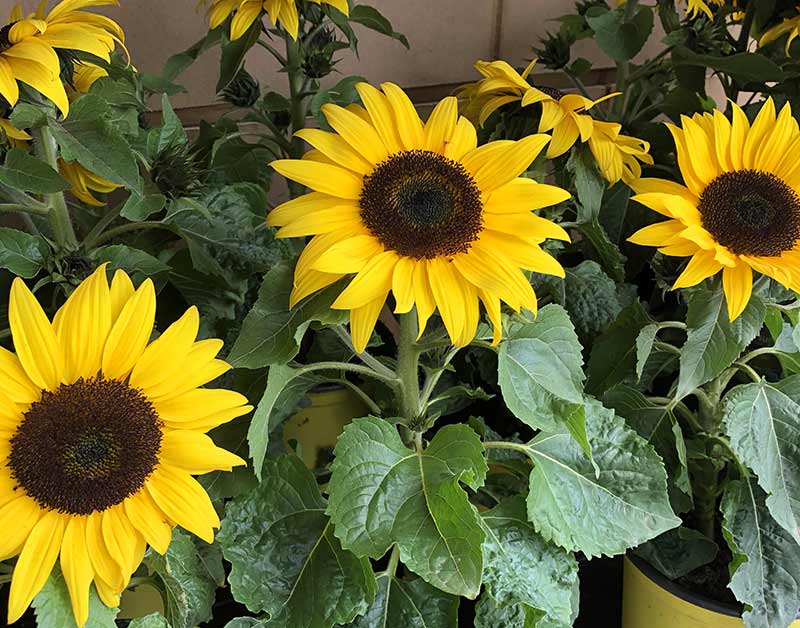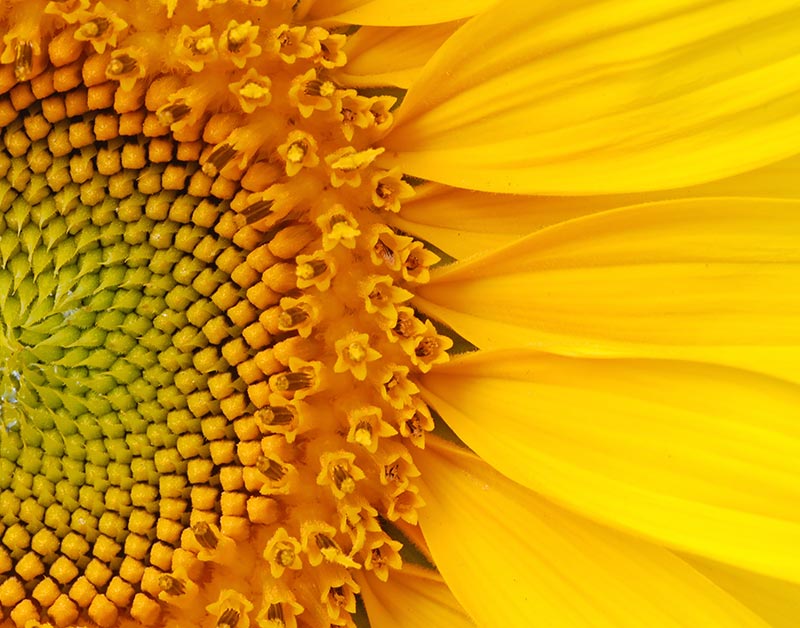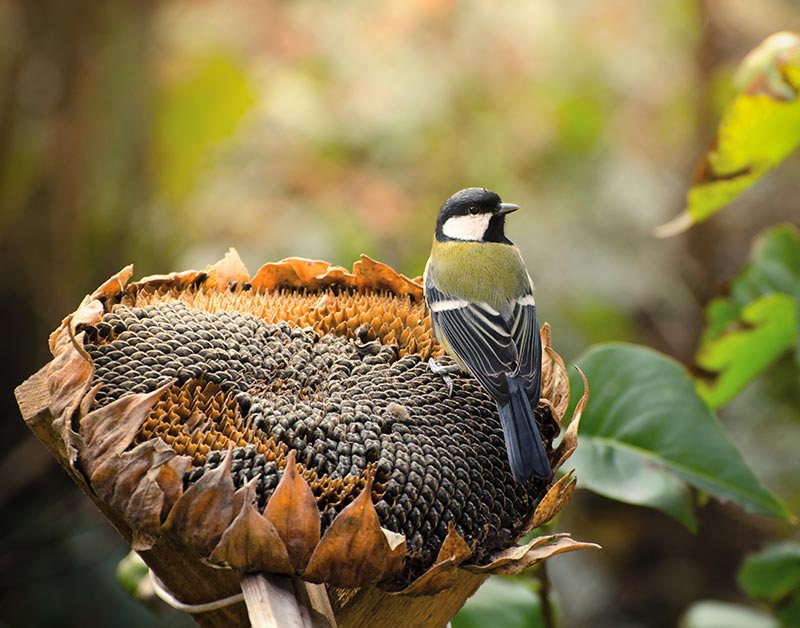How to Grow Sunflowers
It's hard to look at a sunflower and not feel happiness take hold. These simple-to-grow beauties are perfect for everyone, from beginners and kids to experienced gardeners. The hardest part of growing sunflowers is deciding which ones to grow. So jump on board, get ready for sunny blooms and follow these basics for sunflower fun:
- Choosing Your Sunflowers
- Planting Your Sunflowers
- Caring for Sunflowers
- Enjoying Sunflower Blooms and Seeds

Sunflowers come in a wide range of colors, from ivory and yellow to pink and red.
Choosing Your Sunflowers
Botanically speaking, the sunflower family includes annual types that live for a single season and perennials that come back year after year. But the classic, sturdy-stemmed, big-bloomed sunflowers that elevate farm-to-table bouquets are annuals with the botanical name Helianthus annuus. Say "sunflower" to most people, and annuals are the ones that come to mind. Their perennial relatives are pretty, but they don't deliver the big, gorgeous blooms that classic annual sunflowers do.
Sunflowers come in colors and sizes to suit every gardener and garden. Besides the timeless golden flowers, sunflower colors span the spectrum from pale ivory to russet red and nearly black, with centers that range from deep, dark chocolate to mustard yellow.
Some sunflower types offer one flower on each strong stem in a defined bloom time. Others offer branched stems with multiple blooms and extended bloom times. Depending on your tastes, you can choose from dwarf sunflowers ideal for urban balconies to giant sunflowers that tower 15 feet or more. In general, the taller the stalk, the bigger the flower on top.
If you're growing for stunning bouquets, pollen-free types won't drop pollen on your table. (And allergy sufferers in the family will appreciate them, too.) If you're looking to attract pollinators to your garden, only pollen-producing types will do. Not all modern sunflower varieties produce seeds, so if nurturing winter birds is your goal, choose varieties accordingly. And don't worry about kids, cats or dogs; annual sunflowers aren't toxic.1

Dwarf sunflowers are ideal for container gardens.
Planting Your Sunflowers
Sunflowers grow best when grown from seeds planted directly in the ground. Once they start growing, they develop a long central taproot that doesn't like to be disturbed. Roots on large, field-grown sunflowers can reach more than 6 feet deep.1 You can start sunflowers indoors, but transplanting often yields disappointing results. By planting sunflower seeds directly in your garden, as gardeners do with many vegetable seeds, you simplify the process and have stronger, healthier, more productive sunflowers as a result.
Sunflower seedlings tolerate some cool spring temps, but not a surprise late freeze. Wait to plant until two weeks after the last expected spring frost in your area. Choose a site that gets at least six to eight hours of daily sun. Sunflowers aren't picky about soil types or pH.2 Almost any sunny spot will do, as long as soil is well-drained. At planting time, feed your sunflowers with Pennington Rejuvenate Plant Food All Purpose 4-4-4 to nourish new sunflowers and encourage bigger, better blooms. Created to work with nature, this fertilizer revitalizes soil with essential plant nutrients and a blend of organic and natural ingredients to nourish plants from the inside out.
If you're growing several kinds of sunflowers, consider how tall and wide each type grows and where their shade may fall. Plant the tallest types to the north of shorter sunflowers or other plants so that all your flowers get plenty of sun.
Follow the directions on your seed packet for planting depth and spacing. Depending on variety, sunflower seeds may be planted from 1/2 inch to 2 inches deep or more. Plant twice as many seeds as you need — once they germinate and sprout, you'll thin the seedlings.
Most sunflowers sprout in seven to 10 days and mature in two to four months.3 For continuous sunflower harvests, plant seeds every two to three weeks throughout the season — if you have room.

Sunflower heads are composed of tiny flowers.
Caring for Sunflowers
Sunflowers need little attention, but they don't compete well against weeds or other plants. Once seedlings appear, thin your sunflowers so they have more space to grow. And keep your garden weed-free. Allow at least 2 feet between large sunflower varieties and 1 to 1 1/2 feet between smaller types. Crowded sunflowers yield thinner, less sturdy stems and smaller flower heads. If you're growing dwarf types in containers, you may not mind.
Once sunflowers get established and deep taproots grow, they tolerate dry soil. But sufficient moisture is essential during the three weeks before and after blooming. When you water sunflowers, water deeply and thoroughly. Then let the soil dry out slightly before watering again. This encourages deeper root growth and helps prevent discolored yellow and black leaves.
During the growing season, feed your sunflowers again with Pennington Rejuvenate Plant Food All Purpose 4-4-4 to encourage strong growth and bigger, better blooms. Repeat every 4 to 8 weeks during the growing season.
Sunflowers have few native pests, but invasive insects such as Japanese beetles can turn beautiful sunflowers into a tattered mess. With Sevin brand garden pesticides, you can kill and control Japanese beetles, leaf-damaging caterpillars and other ornamental plant pests. It's easy to choose the pesticide product that's right for you.
Sevin Insect Killer Ready To Spray and Sevin Insect Killer Concentrate kill more than 500 listed pests by contact and keep protecting plants for up to three months.+ Sevin Insect Killer Dust Ready to Use, in a convenient shaker container, starts working immediately upon contact to kill more than 150 listed pests — it's ideal for treating smaller plants. And pest control doesn't get any simpler than Sevin Insect Killer Ready To Use2. Just shake the container well, adjust your sprayer nozzle for narrow or wide coverage, and you're set. This easy-to-use liquid kills more than 700 pests on contact to help keep sunflowers at their best.

Songbirds enjoy sunflower seed heads after the flowers pass.
Enjoying Sunflower Blooms and Seeds
To harvest sunflowers for bouquets, cut sunflowers as soon as the petals begin to unfurl and curl back from the flower's face. Harvest your flowers in early morning when they're well-hydrated. As with harvesting garden roses or other fresh-cut flowers, take a bucket of warm water along and put cut stems in water immediately.
Remove all but the uppermost sunflower leaves to extend vase life. Sunflowers in the garden can last several weeks before blooms fade. Fresh-cut single-stem sunflowers last up to 14 days in a vase. Branched types last about half that time.3
If feeding hungry winter birds is your goal, sunflower seeds and seed heads will draw feathery visitors from afar. But cover seed heads with protective mesh bags if birds decide to help themselves before you're ready. Sunflower seeds are ready for harvest when the flower petals wither, heads start to droop and the back of the seed head turns yellow from green.
Harvest the entire head and hang it upside down to dry, as you would hydrangea flowers destined for dried bouquets. Choose a cool, dry spot with good air circulation. When heads are dry, you can remove the seeds or let birds pick the seeds themselves from dried seed heads.
With sunflowers in your garden, you can watch the flower heads turn and follow the sun across the sky each day or enjoy the blooms in brilliant bouquets. From beautiful bright flowers to bird-worthy seeds, sunflowers spell fun for you and your family. With Sevin brand, we're here to help you learn, grow and experience the joys of sunflowers and gardening.
++Except fire ants, fleas, ticks and mosquitoes
Always read product labels thoroughly and follow instructions, including guidelines for pre-harvest intervals (PHI) and application frequency.
GardenTech is a registered trademark of Gulfstream Home & Garden, Inc.
Sevin is a registered trademark of Tessenderlo Kerley, Inc.
Pennington is a registered trademark of Pennington Seed, Inc.
UltraGreen is a registered trademark of Central Garden & Pet Company.
Sources:
1. California Poison Control System, "Plants," The Regents of the University of California.
2. D.H. Putnam, et al., "Alternative Field Crops Manual: Sunflower," University of Wisconsin Extension.
3. L. Byczynski, "How to Choose the Best Sunflower Varieties for Your Needs, " Johnny's Selected Seeds.
Get Monthly Gardening Advice!





